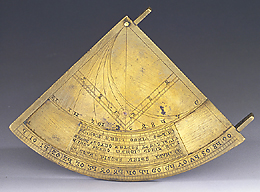
Menu
 |
| Catalogue |
 |
 Quadrant This instrument is one of a group of only three surviving medieval quadrants of this type, the other two being preserved in the Museum of the History of Science, Oxford (c. 1300) and the British Museum, London (14th century). A 16th-century dial of the same type is also preserved in Museo di Storia della Scienza in Florence. The lettering of the three pre-1500 quadrants appears to be distinct, with that of the London and Oxford instruments being closer in style than is either to the Florence example. Anthony J. Turner |



